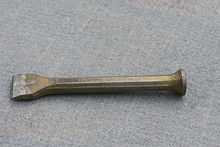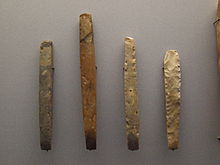Chisel
![]()
The title of this article is ambiguous. For the German football player, see Bernd Meißel.
The chisel (from Middle High German meizel) is a tool used for cutting or working different materials (essentially stone, metal or even bone). It is a tool made of steel with a hardened wedge-like cutting edge and an unhardened striking surface.
Chisels are used with the aid of a hammer to divide workpieces or to separate parts from them. Common types, which exist in various sizes and designs, include flat chisels, grooving chisels, gouging chisels, web chisels (parting chisels) and cross chisels. Special types include the scraper chisel, bossing chisel, percussion chisel, toothed chisel, splitting chisel, etc. (Chisels are called irons by stonemasons). To the hammer the stonemasons say fistula. Handaxes and irons, as well as other hand-held metal tools, are called harnesses by stonemasons and are part of the basic equipment for working stone.
Chisels are used in metalworking by blacksmiths/artisans and metalworkers, in stone working by stonemasons or also in medicine for cutting through bones (osteotomy/stomatology). In addition, there are also motor-driven chisels on demolition hammers, pneumatic hammers, mining hammers and drill hammers.
Lay people also use the terms chisel and chisel interchangeably, contrary to the technical language.

Stonemason's chisel with carbide cutting edge and so-called knob head

Play media file Video: Gunter Demnig divides a paving stone with a chisel and a hammer while laying a Stolperstein in Cologne.
Special chisels
Special irons (chisels) of stonemasons and stone sculptors
- Tooth iron
- Sledgehammer
- Coulter iron
- Pickling iron
- Pointed iron
- Sprengeisen
- Sculpting Journeys
- Dog Tooth
- Kehleisen
- Bossiereisen
Metalworking chisels
- Flat chisel
- Cross-cut chisel
- Grooving chisel
- Mortise chisel (parting chisel)
- Picking chisel - also cold shot chisel (forging technique)
- Shear chisel - also hot scrap chisel (forging technique)
- Setting wood for driving lead sheet in the plumbing industry
- Non-sparking chisels made of beryllium bronze
Milling chisel
Rotating drums fitted with cutting tools are used on cold milling machines in road construction. The cutting tools are shaped like a spinning top and are replaceable.
Drill bit
→ Main article: Drill bit
In deep drilling technology - mostly for the purpose of developing oil and gas deposits - drill heads known as bits are used. The most common form for this purpose is the roller bit, in which toothed bevel gears crush the rock to be drilled through as the bit rotates. Special gouges are commonly used for soil sampling, see Pürckhauer drill bit.

Deep drilling roller bits with 3 toothed bevel gears each
Chisel (Archaeology)
Here, chisels are treated as an object of exploration. (Chisels, on the other hand, can also serve as tools of search in archaeology).
Chisels are long, narrow working tools, which served for chipping. The cross-section may be rectangular or octagonal, round or square. The width of the cutting edge is about the same as the thickness, the length is about 15 cm. The chisel is a shape-changing tool, which is struck with another device. For example, wood and striking stones were suitable as mallets. The chisel can be driven into a material with measured blows (e.g. when splitting whalebone, bone or antler). The gouge is concave (curved inwards) towards the cutting edge and is used for hollowing.
Prehistoric chisels are made of flint, rock, antler, bone, dentine, e.g. from mammoth or amber. They were mainly used in levallois and chipping techniques. They have been known since the end of the Palaeolithic, but were most widely used as narrow or hollow chisels in the Neolithic. Ewald Schuldt found 60 flat and 36 gouges in 106 megalithic sites in Mecklenburg-Vorpommern. The oldest ground bone chisel comes from Přezletice in the Czech Republic and is about 700,000 years old.
The first evidence of chisels made of almost pure copper by smelting dates back to the 6th millennium BC from what is now Serbia (Pločnik). Their cutting edges were cold forged and thus hardened.

Chisel of the Funnel Beaker Culture around 4100 to 2700 BC from Schleswig-Holstein
Search within the encyclopedia